-
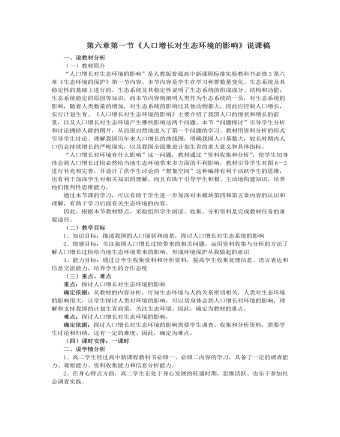
人教版高中生物必修3第六章第一节《人口增长对生态环境的影响》说课稿
3、讨论问题二:我国、我市人口增长对环境有那些影响?教师:让第三、第四组学生分别介绍、展示课前调查到的资料,说明人口增长对我国环境的影响、对三亚市环境的影响。学生:第三组学生派代表介绍人口增长过快对我国生态环境的影响。第四小组由学生自己主持“我市人口增长过快对三亚市生态环境的影响”讨论会,汇报课前调查到的资料和讨论,其它小组参与发言。教师:投影:课本图6-2组织学生讨论、补充和完善。学生:观察老师投影图片并进行讨论,对图片问题进行补充和完善。教学意图:通过让学生汇报、观察、主持,能让学生亲身体验,更深刻地理解人口增长对生态环境的影响,培养和提高学生的表达能力、观察能力、主持会议的能力。4、讨论问题三:怎样协调人与环境的关系?教师:组织第五组学生进行汇报课前调查到的资料,交流、讨论、发表意见和见解。学生:展示课件、图片,汇报调查到的情况,提出合理建议。
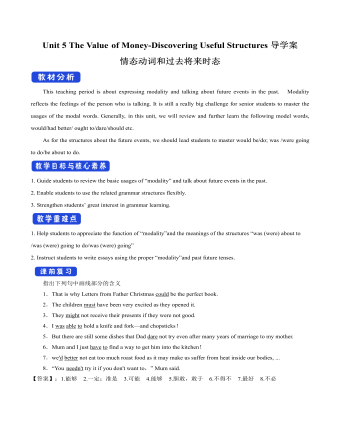
新人教版高中英语必修3Unit 5 The Value of Money-Discovering Useful Structures导学案
4.They were going to find someone to take part in their bet when they saw Henry walking on the street outside.[归纳]1.过去将来时的基本构成和用法过去将来时由“would+动词原形”构成,主要表示从过去某一时间来看将要发生的动作(尤其用于宾语从句中),还可以表示过去的动作习惯或倾向。Jeff knew he would be tired the next day.He promised that he would not open the letter until 2 o'clock.She said that she wouldn't do that again.2.表示过去将来时的其他表达法(1)was/were going to+动词原形:该结构有两个主要用法,一是表示过去的打算,二是表示在过去看来有迹象表明将要发生某事。I thought it was going to rain.(2)was/were to+动词原形:主要表示过去按计划或安排要做的事情。She said she was to get married next month.(3)was/were about to+动词原形:表示在过去看来即将要发生的动作,由于本身已含有“即将”的意味,所以不再与表示具体的将来时间状语连用。I was about to go to bed when the phone rang.(4)was/were+现在分词:表示在过去看来即将发生的动作,通常可用于该结构中的动词是come,go,leave,arrive,begin,start,stop,close,open,die,join,borrow,buy等瞬间动词。Jack said he was leaving tomorrow.
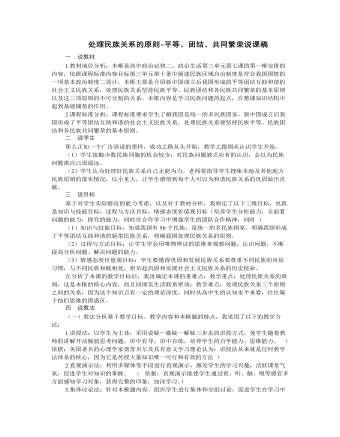
人教版高中政治必修2处理民族关系的原则-平等、团结、共同繁荣说课稿
环节四 情感升华,感悟生活播放《爱我中华》,感受祖国的伟大,民族的团结。设计意图:使学生感受伟大的中华民族的精神,内心产生共鸣,抒发强烈的爱国热情。教师带领学生一起合唱,用歌声结束本堂课内容,能再次唤起学生的爱国情感,使学生认识到:维护国家统一和民族团结是每个公民的义务。环节五 课堂小结 巩固知识本节课我采用线索性的板书,整个知识结构一目了然,为了充分发挥学生在课堂的主体地位,我将课堂小结交由学生完成,请学生根据课堂学习的内容,结合我的板书设计来进行小结,以此来帮助教师在第一时间掌握学生学习信息的反馈,同时培养学生归纳分析能力、概括能力。本节课,我根据建构主义理论,强调学生是学习的中心,学生是知识意义的主动建构者,是信息加工的主体,要强调学生在课堂中的参与性、以及探究性,不仅让他们懂得知识,更让他们相信知识,并且将知识融入到实践当中去,最终达到知、情、意、行的统一。
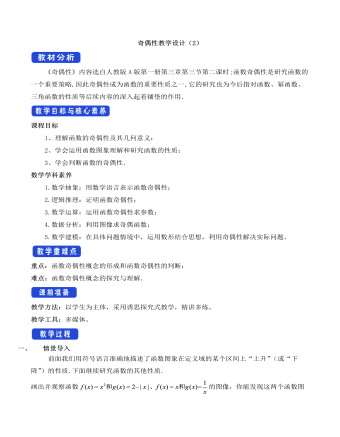
人教A版高中数学必修一奇偶性教学设计(2)
《奇偶性》内容选自人教版A版第一册第三章第三节第二课时;函数奇偶性是研究函数的一个重要策略,因此奇偶性成为函数的重要性质之一,它的研究也为今后指对函数、幂函数、三角函数的性质等后续内容的深入起着铺垫的作用.课程目标1、理解函数的奇偶性及其几何意义;2、学会运用函数图象理解和研究函数的性质;3、学会判断函数的奇偶性.数学学科素养1.数学抽象:用数学语言表示函数奇偶性;2.逻辑推理:证明函数奇偶性;3.数学运算:运用函数奇偶性求参数;4.数据分析:利用图像求奇偶函数;5.数学建模:在具体问题情境中,运用数形结合思想,利用奇偶性解决实际问题。重点:函数奇偶性概念的形成和函数奇偶性的判断;难点:函数奇偶性概念的探究与理解.教学方法:以学生为主体,采用诱思探究式教学,精讲多练。

人教A版高中数学必修一诱导公式教学设计(1)
一、复习回顾,温故知新1. 任意角三角函数的定义【答案】设角 它的终边与单位圆交于点 。那么(1) (2) 2.诱导公式一 ,其中, 。终边相同的角的同一三角函数值相等二、探索新知思考1:(1).终边相同的角的同一三角函数值有什么关系?【答案】相等(2).角 -α与α的终边 有何位置关系?【答案】终边关于x轴对称(3).角 与α的终边 有何位置关系?【答案】终边关于y轴对称(4).角 与α的终边 有何位置关系?【答案】终边关于原点对称思考2: 已知任意角α的终边与单位圆相交于点P(x, y),请同学们思考回答点P关于原点、x轴、y轴对称的三个点的坐标是什么?【答案】点P(x, y)关于原点对称点P1(-x, -y)点P(x, y)关于x轴对称点P2(x, -y) 点P(x, y)关于y轴对称点P3(-x, y)
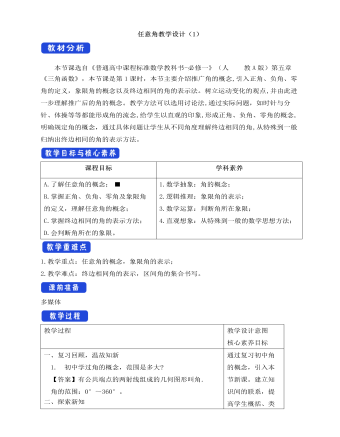
人教A版高中数学必修一任意角教学设计(1)
本节课选自《普通高中课程标准数学教科书-必修一》(人 教A版)第五章《三角函数》,本节课是第1课时,本节主要介绍推广角的概念,引入正角、负角、零角的定义,象限角的概念以及终边相同的角的表示法。树立运动变化的观点,并由此进一步理解推广后的角的概念。教学方法可以选用讨论法,通过实际问题,如时针与分针、体操等等都能形成角的流念,给学生以直观的印象,形成正角、负角、零角的概念,明确规定角的概念,通过具体问题让学生从不同角度理解终边相同的角,从特殊到一般归纳出终边相同的角的表示方法。A.了解任意角的概念;B.掌握正角、负角、零角及象限角的定义,理解任意角的概念;C.掌握终边相同的角的表示方法;D.会判断角所在的象限。 1.数学抽象:角的概念;2.逻辑推理:象限角的表示;3.数学运算:判断角所在象限;4.直观想象:从特殊到一般的数学思想方法;
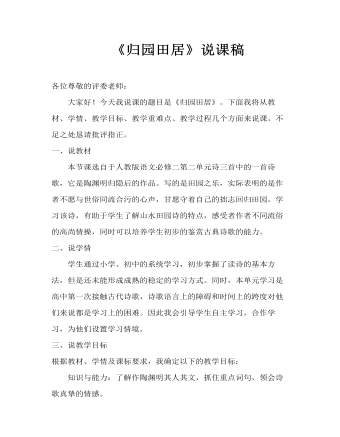
高中语文人教版必修二《归园田居》说课稿
一、说教材本节课选自于人教版语文必修二第二单元诗三首中的一首诗歌,它是陶渊明归隐后的作品。写的是田园之乐,实际表明的是作者不愿与世俗同流合污的心声,甘愿守着自己的拙志回归田园。学习该诗,有助于学生了解山水田园诗的特点,感受者作者不同流俗的高尚情操,同时可以培养学生初步的鉴赏古典诗歌的能力。
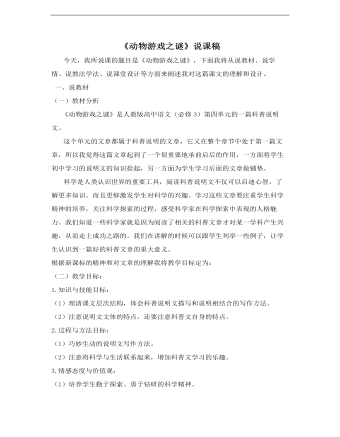
高中语文人教版必修三《动物游戏之谜》说课稿
科学是人类认识世界的重要工具,阅读科普说明文不仅可以启迪心智,了解更多知识。而且更够激发学生对科学的兴趣。学习这些文章要注重学生科学精神的培养,关注科学探索的过程,感受科学家在科学探索中表现的人格魅力。我们知道一些科学家就是因为阅读了相关的科普文章才对某一学科产生兴趣,从而走上成功之路的。我们在讲解的时候可以跟学生列举一些例子,让学生认识到一篇好的科普文章的重大意义。
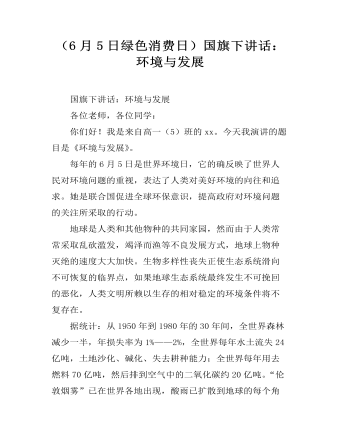
(6月5日绿色消费日)国旗下讲话:环境与发展
每年的6月5日是世界环境日,它的确反映了世界人民对环境问题的重视,表达了人类对美好环境的向往和追求。她是联合国促进全球环保意识,提高政府对环境问题的关注所采取的行动。地球是人类和其他物种的共同家园,然而由于人类常常采取乱砍滥发,竭泽而渔等不良发展方式,地球上物种灭绝的速度大大加快。生物多样性丧失正使生态系统滑向不可恢复的临界点,如果地球生态系统最终发生不可挽回的恶化,人类文明所赖以生存的相对稳定的环境条件将不复存在。
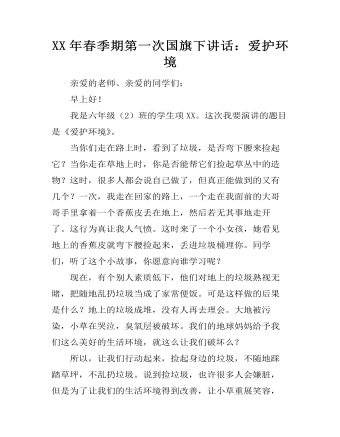
XX年春季期第一次国旗下讲话:爱护环境
亲爱的老师、亲爱的同学们:早上好!我是六年级(2)班的学生项XX。这次我要演讲的题目是《爱护环境》。 当你们走在路上时,看到了垃圾,是否弯下腰来捡起它?当你走在草地上时,你是否能帮它们捡起草丛中的造物?这时,很多人都会说自己做了,但真正能做到的又有几个?一次,我走在回家的路上,一个走在我面前的大哥哥手里拿着一个香蕉皮丢在地上,然后若无其事地走开了。这行为真让我人气愤。这时来了一个小女孩,她看见地上的香蕉皮就弯下腰捡起来,丢进垃圾桶理你。同学们,听了这个小故事,你愿意向谁学习呢?现在,有个别人素质低下,他们对地上的垃圾熟视无睹,把随地乱扔垃圾当成了家常便饭。可是这样做的后果是什么?地上的垃圾成堆,没有人再去理会。大地被污染,小草在哭泣,臭氧层被破坏。我们的地球妈妈给予我们这么美好的生活环境,就这么让我们破坏么?
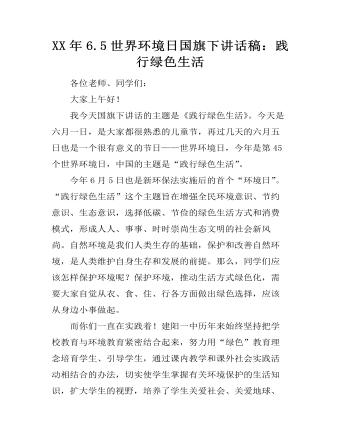
XX年6.5世界环境日国旗下讲话稿:践行绿色生活
各位老师、同学们:大家上午好!我今天国旗下讲话的主题是《践行绿色生活》。今天是六月一日,是大家都很熟悉的儿童节,再过几天的六月五日也是一个很有意义的节日——世界环境日,今年是第45个世界环境日,中国的主题是“践行绿色生活”。今年6月5日也是新环保法实施后的首个“环境日”。“践行绿色生活”这个主题旨在增强全民环境意识、节约意识、生态意识,选择低碳、节俭的绿色生活方式和消费模式,形成人人、事事、时时崇尚生态文明的社会新风尚。自然环境是我们人类生存的基础,保护和改善自然环境,是人类维护自身生存和发展的前提。那么,同学们应该怎样保护环境呢?保护环境,推动生活方式绿色化,需要大家自觉从衣、食、住、行各方面做出绿色选择,应该从身边小事做起。而你们一直在实践着!建阳一中历年来始终坚持把学校教育与环境教育紧密结合起来,努力用“绿色”教育理念培育学生、引导学生,通过课内教学和课外社会实践活动相结合的办法,切实使学生掌握有关环境保护的生活知识,扩大学生的视野,培养了学生关爱社会、关爱地球、关爱他人的美好情操,受到社会各界的肯定和广泛赞誉。
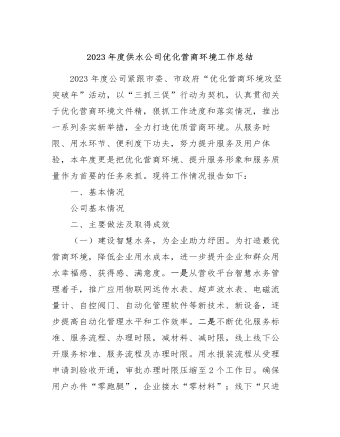
2023年度供水公司优化营商环境工作总结
四是每年坚持委托第三方检测机构对管网水43项及出厂水97项水质指标进行检测分析,从严把好水质安全关,确保市民喝上干净水、安全水、放心水。五是对办理用水报装业务的单位及个人主要申请材料齐全且符合,但次要条件或申请材料欠缺的供水报装服务事项,经过申请人作出相应承诺后,公司将先予受理和办理,建立容缺受理机制。六是对在建项目开通“先通水后办理”绿色通道,建立临时用水机制。二、存在问题及下一步打算目前,公司采用的物联网管理营收平台,已能实现大部分用水户网上缴费,提高了自动化管理水平和工作效率,但智能水表普及率仍然偏低。下一步,我公司将持续深化“优化营商环境攻坚突破年”活动,用实际行动架起供水企业和用水客户的“连心桥”,不断提高用水供给和服务质量。一是加快接市政工程建设项目审批系统,实现“水、气、电、暖”“一窗通办”,进一步提高办事效率。二是加快建设公司公众号建设,满足不同用户需求,使用户通过公众号实现供水报装、水费查询和缴纳等相关业务。三是进一步推进智慧水务建设,计划2023年至2025年逐步更换改造物联网水表4000台,力争2030年全面普及智能水表。
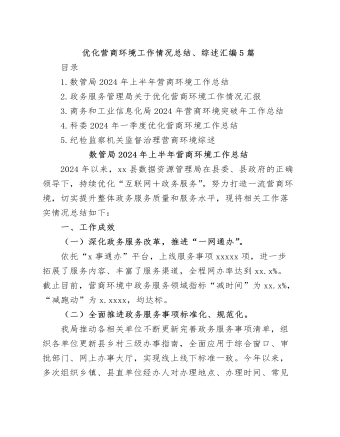
(5篇)优化营商环境工作情况总结、综述汇编
三是用好科技企业培育平台。启动2024年度科技型中小企业评价工作,帮助企业享受研发费用xxx%加计扣除政策,截至目前,全区参评企业xxx家,其中高新技术企业xxx家,已有xx家入库,另有xx家正在公示。(四)找准“需求点”,精准服务企业有温度。一是创新施策,优化创新生态体系。为进一步精准服务企业,区科委由“管理思维”转变为“服务视角”,草拟了《xx区创新生态服务体系“一点即办”工作方案》,采取线上线下相结合的方式,走访征集企业需求,根据不同需求分类,组织相关部门召开专题会,积极协调响应企业需求。已收集需求xxx项,涉及空间需求、政策解读、资金支持、人才落户、子女入学、人才居住、疫情防控等x方面,已解决xxx项、正在推进xx项。针对玛诺生物制药股份有限公司生产资金短缺问题,积极对接区内银行提供金融服务。
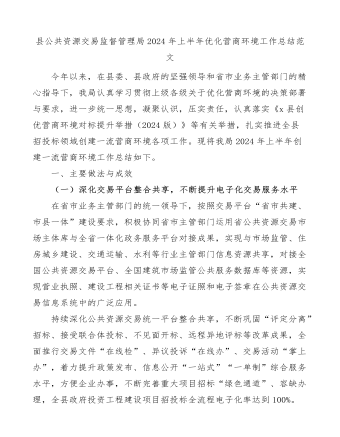
2024年上半年优化营商环境工作总结汇报报告
一是进一步强化工作举措。紧盯创建一流招投标市场营商环境工作目标,深入开展招投标领域对标提升行动,扎实开展包联企业走访,进一步创新方法,强化措施,着力解决全县招投标领域的“难点”“痛点”“堵点”问题,加快推进地方建筑业企业高质量发展。二是进一步加强工作宣传。大力开展《优化营商环境条例》《安徽省实施〈优化营商环境条例〉办法》等政策法规的宣贯活动,帮助企业树牢规矩意识、大局意识、自律意识,着力增强政企互信,做到相互理解、相互支持,引导企业依法维护合法权益。三是进一步完善长效机制。认真贯彻执行优化营商环境的政策措施,持续修订、完善招投标监管制度、操作规程及交易规则,进一步厘清职责、理顺关系,一体推进标前、标中、标后监管,着力构建创建一流招投标市场营商环境的长效常态机制。
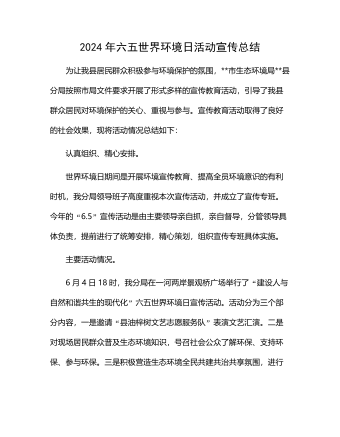
2024年六五世界环境日活动宣传总结
为让我县居民群众积极参与环境保护的氛围,**市生态环境局**县分局按照市局文件要求开展了形式多样的宣传教育活动,引导了我县群众居民对环境保护的关心、重视与参与。宣传教育活动取得了良好的社会效果,现将活动情况总结如下:认真组织、精心安排。世界环境日期间是开展环境宣传教育、提高全员环境意识的有利时机,我分局领导班子高度重视本次宣传活动,并成立了宣传专班。今年的“6.5”宣传活动是由主要领导亲自抓,亲自督导,分管领导具体负责,提前进行了统筹安排,精心策划,组织宣传专班具体实施。主要活动情况。6月4日18时,我分局在一河两岸景观桥广场举行了“建设人与自然和谐共生的现代化”六五世界环境日宣传活动。活动分为三个部分内容,一是邀请“县油梓树文艺志愿服务队”表演文艺汇演。二是对现场居民群众普及生态环境知识,号召社会公众了解环保、支持环保、参与环保。
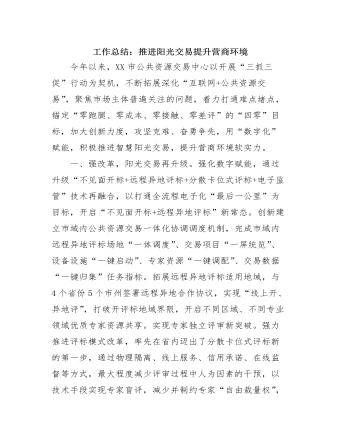
工作总结:推进阳光交易提升营商环境
针对招标(采购)文件容易出现的问题,明确正负面清单,推出前置告知和现场告知措施,进场时限从原来的2—3天缩减到1小时以内,做到“即提即办”。压缩保证金退付时限。由原来的5日缩减为1日,及时解除投标保证金占用企业现金流的情况。全面完善“绿色通道”机制,实行“容缺受理”,缩减审核等相关环节需要的时间,尽量做到能上则上、能早则早、能快则快,使项目尽快进入交易程序。提供贴心服务。健全“店小二”服务模式,配备“帮办代办”专员,对需现场办理的业务,“帮办代办”专员提前主动与招标(采购)主体联系对接,一次性告知所需材料,提交后一次性办结;对交易主体不能到场的,委托“帮办代办”专员全程办理有关交易事项,实现了项目交易“最多只跑一次腿”,甚至“一次都不跑”的工作目标。
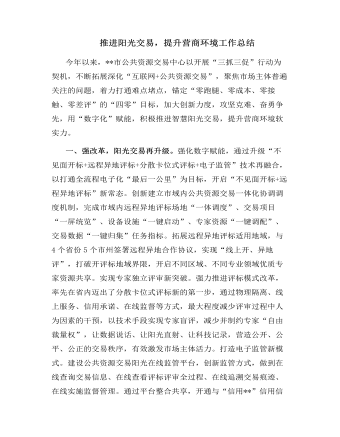
工作总结:推进阳光交易 提升营商环境
一、强改革,阳光交易再升级。强化数字赋能,通过升级“不见面开标+远程异地评标+分散卡位式评标+电子监管”技术再融合,以打通全流程电子化“最后一公里”为目标,开启“不见面开标+远程异地评标”新常态。创新建立市域内公共资源交易一体化协调调度机制,完成市域内远程异地评标场地“一体调度”、交易项目“一屏统览”、设备设施“一键启动”、专家资源“一键调配”、交易数据“一键归集”任务指标。拓展远程异地评标适用地域,与4个省份5个市州签署远程异地合作协议,实现“线上开、异地评”,打破开评标地域界限,开启不同区域、不同专业领域优质专家资源共享。实现专家独立评审新突破。强力推进评标模式改革,率先在省内迈出了分散卡位式评标新的第一步,通过物理隔离、线上服务、信用承诺、在线监督等方式,最大程度减少评审过程中人为因素的干预,以技术手段实现专家盲评,减少并制约专家“自由裁量权”,让数据说话、让阳光直射、让科技记录,营造公开、公平、公正的交易秩序,有效激发市场主体活力。打造电子监管新模式。
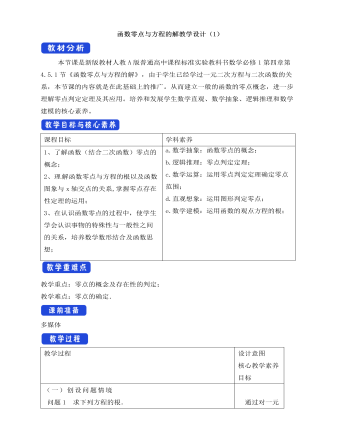
人教A版高中数学必修一函数的零点与方程的解教学设计(1)
本节课是新版教材人教A版普通高中课程标准实验教科书数学必修1第四章第4.5.1节《函数零点与方程的解》,由于学生已经学过一元二次方程与二次函数的关系,本节课的内容就是在此基础上的推广。从而建立一般的函数的零点概念,进一步理解零点判定定理及其应用。培养和发展学生数学直观、数学抽象、逻辑推理和数学建模的核心素养。1、了解函数(结合二次函数)零点的概念;2、理 解函数零点与方程的根以及函数图象与x轴交点的关系,掌握零点存在性定理的运用;3、在认识函数零点的过程中,使学生学会认识事物的特殊性与一般性之间的关系,培养数学数形结合及函数思想; a.数学抽象:函数零点的概念;b.逻辑推理:零点判定定理;c.数学运算:运用零点判定定理确定零点范围;d.直观想象:运用图形判定零点;e.数学建模:运用函数的观点方程的根;
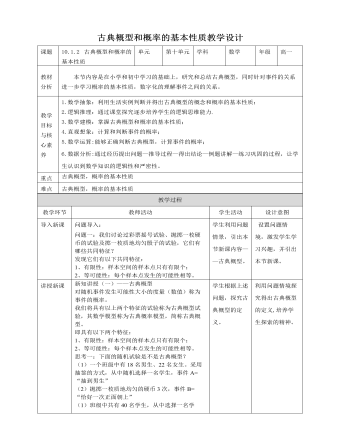
人教A版高中数学必修二古典概型和概率的基本性质教学设计
新知讲授(一)——古典概型 对随机事件发生可能性大小的度量(数值)称为事件的概率。我们将具有以上两个特征的试验称为古典概型试验,其数学模型称为古典概率模型,简称古典概型。即具有以下两个特征:1、有限性:样本空间的样本点只有有限个;2、等可能性:每个样本点发生的可能性相等。思考一:下面的随机试验是不是古典概型?(1)一个班级中有18名男生、22名女生。采用抽签的方式,从中随机选择一名学生,事件A=“抽到男生”(2)抛掷一枚质地均匀的硬币3次,事件B=“恰好一次正面朝上”(1)班级中共有40名学生,从中选择一名学生,即样本点是有限个;因为是随机选取的,所以选到每个学生的可能性都相等,因此这是一个古典概型。
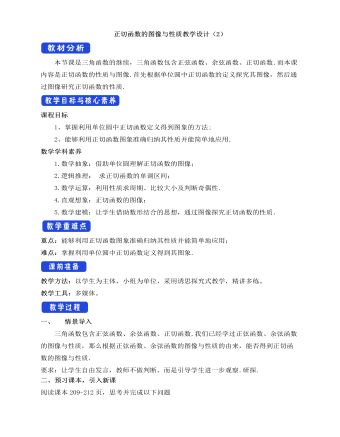
人教A版高中数学必修一正切函数的图像与性质教学设计(2)
本节课是三角函数的继续,三角函数包含正弦函数、余弦函数、正切函数.而本课内容是正切函数的性质与图像.首先根据单位圆中正切函数的定义探究其图像,然后通过图像研究正切函数的性质. 课程目标1、掌握利用单位圆中正切函数定义得到图象的方法;2、能够利用正切函数图象准确归纳其性质并能简单地应用.数学学科素养1.数学抽象:借助单位圆理解正切函数的图像; 2.逻辑推理: 求正切函数的单调区间;3.数学运算:利用性质求周期、比较大小及判断奇偶性.4.直观想象:正切函数的图像; 5.数学建模:让学生借助数形结合的思想,通过图像探究正切函数的性质. 重点:能够利用正切函数图象准确归纳其性质并能简单地应用; 难点:掌握利用单位圆中正切函数定义得到其图象.





















